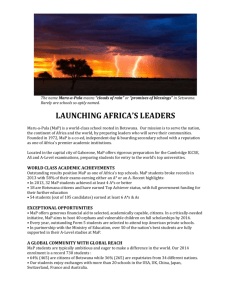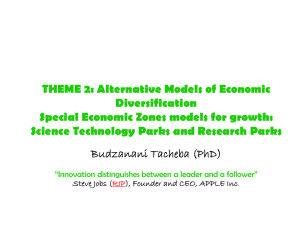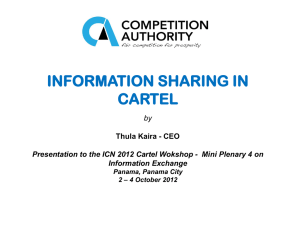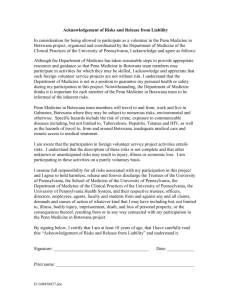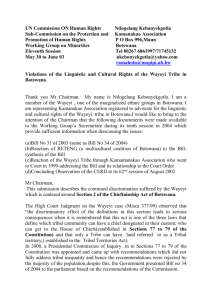Facilitating Expansive school Transformation Using ICT in the SADC
advertisement
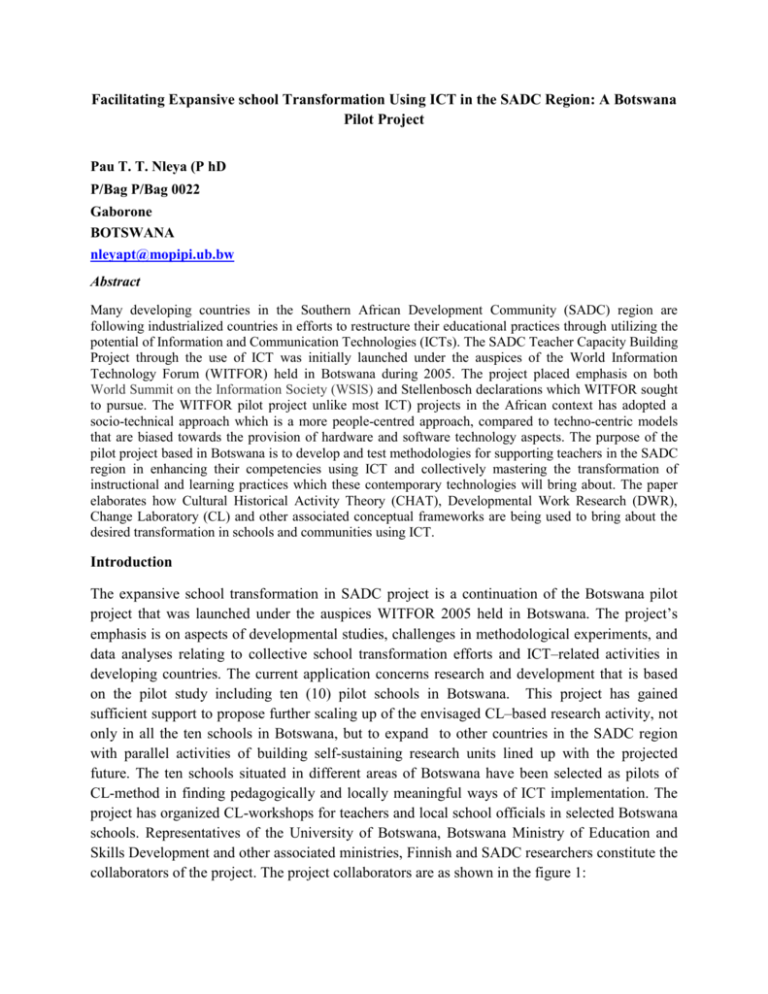
Facilitating Expansive school Transformation Using ICT in the SADC Region: A Botswana Pilot Project Pau T. T. Nleya (P hD P/Bag P/Bag 0022 Gaborone BOTSWANA nleyapt@mopipi.ub.bw Abstract Many developing countries in the Southern African Development Community (SADC) region are following industrialized countries in efforts to restructure their educational practices through utilizing the potential of Information and Communication Technologies (ICTs). The SADC Teacher Capacity Building Project through the use of ICT was initially launched under the auspices of the World Information Technology Forum (WITFOR) held in Botswana during 2005. The project placed emphasis on both World Summit on the Information Society (WSIS) and Stellenbosch declarations which WITFOR sought to pursue. The WITFOR pilot project unlike most ICT) projects in the African context has adopted a socio-technical approach which is a more people-centred approach, compared to techno-centric models that are biased towards the provision of hardware and software technology aspects. The purpose of the pilot project based in Botswana is to develop and test methodologies for supporting teachers in the SADC region in enhancing their competencies using ICT and collectively mastering the transformation of instructional and learning practices which these contemporary technologies will bring about. The paper elaborates how Cultural Historical Activity Theory (CHAT), Developmental Work Research (DWR), Change Laboratory (CL) and other associated conceptual frameworks are being used to bring about the desired transformation in schools and communities using ICT. Introduction The expansive school transformation in SADC project is a continuation of the Botswana pilot project that was launched under the auspices WITFOR 2005 held in Botswana. The project’s emphasis is on aspects of developmental studies, challenges in methodological experiments, and data analyses relating to collective school transformation efforts and ICT–related activities in developing countries. The current application concerns research and development that is based on the pilot study including ten (10) pilot schools in Botswana. This project has gained sufficient support to propose further scaling up of the envisaged CL–based research activity, not only in all the ten schools in Botswana, but to expand to other countries in the SADC region with parallel activities of building self-sustaining research units lined up with the projected future. The ten schools situated in different areas of Botswana have been selected as pilots of CL-method in finding pedagogically and locally meaningful ways of ICT implementation. The project has organized CL-workshops for teachers and local school officials in selected Botswana schools. Representatives of the University of Botswana, Botswana Ministry of Education and Skills Development and other associated ministries, Finnish and SADC researchers constitute the collaborators of the project. The project collaborators are as shown in the figure 1: Figure 1: Pilot Project Collaborators International SADC collaboration Ministry of Education University of Botswana MoLD, MoST Department of Educational technology Developer education Research collaboration University of Helsinki Centre for Research on Activity, Development and Learnning Research and development, 4 CL interventions Policy ATIG Policy Ten pilotschools & informal education Teacher training and media centres in their communities Project Collaborators’ List Helsinki University of Technology (HUT) – Life Long Learning Institute Dipoli Helsinki University (HU) – Center for Activity Theory and Developmental Work Research University of Cape Town (Republic of South Africa) University of Mauritius – Virtual Centre for Innovative Learning Technologies (VICILT) University of Botswana (UB) Department of Educational Technology (DET) Ministry of Education (MoE) – houses the ten (10) pilot schools and Teacher Training and Development (TT&D) serves as coordinator. Ministry of Communication Science and Technology (MCST) – houses MAITLAMO Policy Botswana College of Distance Open Learning (BOCODOL) – houses SADC-CDE Activity Theory Interest Group (ATIG) The project also places emphasis on both World Summit on the Information Society (WSIS) and Stellenbosch declarations which WITFOR sought to pursue. WSIS which took place in Tunis during November 2005 was conceived as a Summit in two phases and later developed a strategy for implementation at the level of these two phases. The process was guided by a comprehensive implementation plan which encompasses the national, regional, international as well as well as an inter-agency coordination component. Individual governments at the national level played the leadership role. The Stellenbosch declarations on the other hand recommend that stakeholders and decision-makers in ICT in Education focus on six (6) major areas that will shape beneficial use of ICT in Education: • Digital Solidarity; • Learners and lifelong learning; • Decision-making strategies; • Networking; • Research; • Teachers. For each of these areas, recommendations and proposals on a set of possible actions were formulated as follows: ICT changes teaching & learning in a networked world Technology matters BUT good teaching matters more Teachers are key agents in educational systems and are instruments in the evolution of Education Teaching profession therefore needs to evolve strongly and quickly (http://www.terry-freedman.org.uk/artman/uploads/thestellenboschdeclaration.pdf) The human element in school reform, especially in ICT integration cannot be overemphasized. Scheingold (1990) has aptly put it when he wrote: … the challenge of integrating technology into schools and classrooms is much more human than it is technological ... it is not fundamentally about helping people to operate machines. Rather it is about helping people, primarily teachers, integrate these technologies into their teaching as tools of a profession that is being redefined through the incorporation process Scheingold, (1990) pp. 9-27). This contention is worth remembering if teachers’ Continuing Professional Development (CPD) in ICT is to be supported. 0bjectives Identified for the Project The following have been identified for the project: i. Training, application, adaptation and development of the Cultural Historical Activity Theory (CHAT) and other methodologies in the context of school and community transformation. ii. Planning, developing and implementing training to support educational transformation among teachers in a pilot project of ten (10) secondary schools. iii. Training of change agents for school and community transformation and new uses of Information and Communication Technologies (ICTs) iv. The establishment of a virtual community of practice network for enhancing the teachers in the pilot project and the SADC region. v. Engagement in Developmental Work Research (DWR) on school and community transformation using Change Laboratory method. vi. Diffusion of innovative learning and knowledge communities project to SADC region through collaborative projects Conceptual Frameworks of the Project The project has adopted a socio-technical approach which is a more people-centred approach, compared to techno-centric models that are biased towards the provision of hardware and software technologies. Aspects of Cultural Historical Activity Theory (CHAT), Developmental Work Research (DWR), Change Laboratory (CL) and other associated conceptual frameworks are being used to bring about the desired transformation in schools and communities within the pilot project through the use of ICT. Research Methodology of Pilot Project The most important method prescribed for the pilot project is the Change Laboratory (CL) process that allows local communities to reflect on their present practices as well as engage in deliberate design of ICT-transformed practices. Figure 2: The Cycle of Expansive Learning – Change Laboratory Method According to the CL method, the cycle of expansive learning associated with bringing transformation can be outlined as follows: 1. Charting the situation • Mirror for questioning the present practice • Recognizing that something must be done • Commitment to develop 2. Analyzing the situation • Mirror for analysis, modeling contradictions in the activity system • How did we work in the past? • What are our present troubles and contradictions? 3. Creating a new activity model • How are we going to work next year? 4. Concretizing and testing the new model • What changes do we try next month? 5. Implementing the new activity model • Putting first steps into practice • Pushing the next steps 6. Consolidating and spreading the new practice • Teaching others what we have learned • Codifying the new rules etc. Activity System of Project The project collaborators intend to further organize in each SADC country (Botswana, Mauritius, and RSA), two (2) one-week CL workshops during which participants analyze their respective activity systems as well their history so as to plan appropriate changes that arise as a consequence of starting to use ICTs. The activity system of the project is shown in figure 3: Figure 3: Activity system of the Botswana Pilot Project The activity system ICT IMPLEMENTS ICT SKILLS CHANGE LAB CHANGE OF MINDSET Instruments: tools and signs Object TEACHER/ STUDENT MANAGEMENT sense, Subject meaning Rules A. TIME TABLING (COMPUTER LABS) Community PTA C. OTHER COMPUTER REGULATIONS POLICY MAKERS Outcome CITIZENS WITH HIGH LEVELS OF ICT LITERACY Division of labor PROVIDERS OUTSIDE THE SCHOOL B. TEACHING LOADS D. POLICIES ICT INTERGRATION ACROSS THE CURRICILUM MINISTRIAL AND SCHOOL LEVEL COORDINATION (CDNE, DEPT SEC, SMT). MOE DEPARTMENTS e.g. TT&D AND DNFE Towards a School and Community Transformation Model The proposed model for school transformation used adheres to four historical types of schools as exemplified in figure 4. The objective of the pilots is to discuss the vision of the participants regarding which direction they want their school to develop in the long run. From the first CL ideas, three ideas of experimenting were produced, firstly, student motivation and involved in a new way of collecting and utilizing knowledge about individual students’ study history, situation and special needs. Secondly, developing a form of collaborative teaching between teachers, and thirdly, identifying a better way of implementing reforms in the school (that seemed often remain unimplemented despite workshops being arranged). More work is to be done on these ideas so as to adopt some operational model. Figure 4: A School Transformation Strategy The participants have agreed that the future direction has to focus on a community developer school model given the prevalent problems caused by HIV/AIDS as well as other pressing community related problems which necessitates some boundary crossing. Molefi School has adopted a strategy where all stake holders work together to contribute in resolving these prevalent challenges. The CL continues to experiment with the above mentioned three innovative ideas so as to establish authentic models that could lead to some real transformation. Outcomes of the Project The present project will produce scientifically sound data, and thus knowledge, concerning applicability of CL methodology for facilitating educational transformation in developing countries linked with their starting to use ICTs. The proposed investigations will help to specify challenges and constraints regarding ICT-related educational transformations, and, thereby, assist in designing new interventions. Further, the project will produce information concerning current practices of learning and instruction in schools in the SADC region. The results of the present project will be published in a series of symposiums and conference presentations (e.g., AAA, AERA, CSCL, EARLI, ICLS, IFIP) as well as scientific articles. We will produce one co-edited book regarding how to support ICT-based educational transformations by change-laboratory interventions in developing countries as well as a guidebook concerning change-laboratory intervention. The results will be disseminated through national and regional conferences and workshops in SADC area and WITFOR conference Other Outcomes There will be a wide range of other outcomes from both the pilot project and the SADC-wide continuation component. Individual collaborators are working on individual proposals to be integrated into the National Development Plan 10 (NDP 10). The following is a list of some of the intended outcomes: 1. Center for Activity Theory and Developmental Work Research within the University of Botswana responsible for carrying out Developmental Work Research based on Activity Theory on the educational activities of schools and teacher education in Botswana. 2. Post graduate training of change agents for school and community transformation and new uses of Information and Communication Technologies (ICTs) at the University of Botswana. 3. Adopted Developmental Work Research (DWR) and Change Laboratory methodologies as authentic “Action Research’ model for Botswana schools, institutions and communities. 4. Virtual community of practice serving SADC-wide region in eLearning, school and community transformation using Activity Theory and Change Laboratory. 5. Links with best practice centres of Activity Theory in the world (i. e. Center for Activity Theory and Developmental Work Research in the University of Helsinki, Centre for Activity Theory and Socio-cultural Research, University of Bath, UK and Center for Human Activity Theory, Kansai University, Osaka, Japan. 6. DWR projects based at ‘Kitsong ICT Community centres to promote eLearning in line with MAITLAMO and Vision 2016 ideals. 7. A network of school developers applying the Change Laboratory method in SADC region after the pilot. Application and Utilization of Results CL involves a structured method of intervention; consequently, the resulting data, rigorously collected and properly analyzed, are the basis for advances in scientific knowledge. Such knowledge is not only academically interesting, but will also assist other developing countries in pursuing corresponding educational improvements through ICTs. Moreover, the present investigation will contribute to the advancement of Botswana’s, Mauritius’ and South Africa’s own multi-disciplinary research network concerning ICT-based educational transformation. Beyond strengthening collaborators’ own research network, it will create an international network of teachers and school administrators for supporting, creating and the building of a global knowledge society. Furthermore, the collaboration will have a scientific understanding of the process of their creation. References Engeström, Y, Engeström, R., & Suntio, A. (2002). Can a school community learn to master its own future? An activity theoretical study of expansive earning among middle school teachers. In G.Wells & G. Claxton (Eds.), Learning for life in the 21st Century. Sociocultural perspectives on the future of education. Pp.211-224. Cambridge, MA: Blackwell. Engeström, Y., Virkkunen, J., Helle, M., Pihlaja, J., & Poikela, R. (1996). The Change Laboratory as a Tool for Transforming Work. Lifelong Learning in Europe, 2/1996, 1017. Scheingold, K., (1990) Restructuring for learning with technology. The Potential for Synergy. In K. Sheingold and M. Tacher (Eds), Restructuring for learning with technology, (pp. 927). New York: Bank Street College of Education: Center for Technology in Education. Stellenbosch Declaration (2005) 8th IFIP World Congress on Computer Education (WCCE) http://www.terry-freedman.org.uk/artman/uploads/thestellenboschdeclaration.pdf retrieved on 15/04/2009 ______________________
